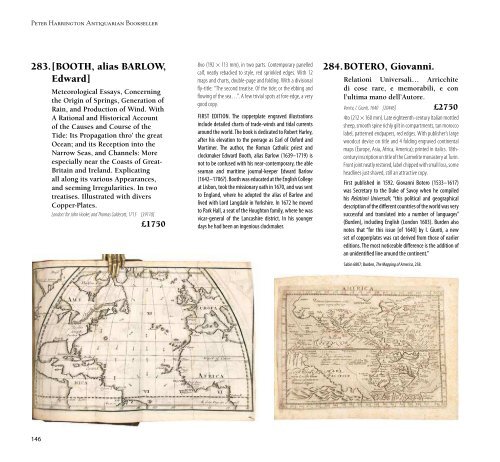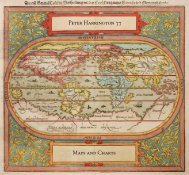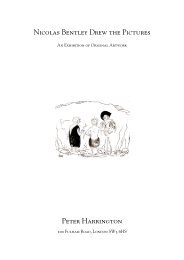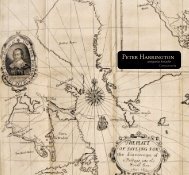antiquarian bookseller - Peter Harrington
antiquarian bookseller - Peter Harrington
antiquarian bookseller - Peter Harrington
Create successful ePaper yourself
Turn your PDF publications into a flip-book with our unique Google optimized e-Paper software.
<strong>Peter</strong> <strong>Harrington</strong> Antiquarian Bookseller<br />
283.[BOOTH, alias BARLOW,<br />
Edward]<br />
Meteorological Essays, Concerning<br />
the Origin of Springs, Generation of<br />
Rain, and Production of Wind. With<br />
A Rational and Historical Account<br />
of the Causes and Course of the<br />
Tide: Its Propagation thro’ the great<br />
Ocean; and its Reception into the<br />
Narrow Seas, and Channels: More<br />
especially near the Coasts of Great-<br />
Britain and Ireland. Explicating<br />
all along its various Appearances,<br />
and seeming Irregularities. In two<br />
treatises. Illustrated with divers<br />
Copper-Plates.<br />
London: for John Hooke; and Thomas Caldecott, 1715 [39110]<br />
£1750<br />
8vo (192 × 113 mm), in two parts. Contemporary panelled<br />
calf, neatly rebacked to style, red sprinkled edges. With 12<br />
maps and charts, double-page and folding. With a divisional<br />
fly-title: “The second treatise. Of the tide; or the ebbing and<br />
flowing of the sea…”. A few trivial spots at fore edge, a very<br />
good copy.<br />
FIRST EDITION. The copperplate engraved illustrations<br />
include detailed charts of trade-winds and tidal currents<br />
around the world. The book is dedicated to Robert Harley,<br />
after his elevation to the peerage as Earl of Oxford and<br />
Mortimer. The author, the Roman Catholic priest and<br />
clockmaker Edward Booth, alias Barlow (1639–1719) is<br />
not to be confused with his near-contemporary, the able<br />
seaman and maritime journal-keeper Edward Barlow<br />
(1642–1706?). Booth was educated at the English College<br />
at Lisbon, took the missionary oath in 1670, and was sent<br />
to England, where he adopted the alias of Barlow and<br />
lived with Lord Langdale in Yorkshire. In 1672 he moved<br />
to Park Hall, a seat of the Houghton family, where he was<br />
vicar-general of the Lancashire district. In his younger<br />
days he had been an ingenious clockmaker.<br />
284.BOTERO, Giovanni.<br />
Relationi Universali… Arricchite<br />
di cose rare, e memorabili, e con<br />
l’ultima mano dell’Autore.<br />
Venice, I. Giunti, 1640 [20446] £2750<br />
4to (212 × 160 mm). Late eighteenth-century Italian mottled<br />
sheep, smooth spine richly gilt in compartments, tan morocco<br />
label, patterned endpapers, red edges. With publisher’s large<br />
woodcut device on title and 4 folding engraved continental<br />
maps (Europe, Asia, Africa, America); printed in italics. 18thcentury<br />
inscription on title of the Carmelite monastery at Turin.<br />
Front joint neatly restored, label chipped with small loss, some<br />
headlines just shaved, still an attractive copy.<br />
First published in 1592. Giovanni Botero (1533–1617)<br />
was Secretary to the Duke of Savoy when he compiled<br />
his Relationi Universali; “this political and geographical<br />
description of the different countries of the world was very<br />
successful and translated into a number of languages”<br />
(Burden), including English (London 1603). Burden also<br />
notes that “for this issue [of 1640] by I. Giunti, a new<br />
set of copperplates was cut derived from those of earlier<br />
editions. The most noticeable difference is the addition of<br />
an unidentified line around the continent.”<br />
Sabin 6807; Burden, The Mapping of America, 258.<br />
285.BOURDE DE<br />
VILLEHUET, Jacques.<br />
Le Manoeuvrier, ou Essai sur<br />
la Thoerie et la Pratique des<br />
Mouvemens du Navire et des<br />
Evolutions Navales. Par… Officier<br />
des Vaisseaux de la Compagnie des<br />
Indes.<br />
Chez Desaint, Paris, 1769 [36941] £450<br />
8vo. 8 folding plates. Some browning, particularly in the<br />
prelims, but overall very good in contemporary mottled sheep,<br />
spine gilt in compartments, some erosion and stripping from<br />
the boards, corners worn, nonetheless a presentable copy.<br />
Second edition, identical with the first of 1765. An<br />
important influence on the development of English naval<br />
thought. “Though less illuminating on fundamental<br />
principles than Morogues its methods of handling a<br />
fleet are more fully elaborated, and it ends by heralding<br />
the final reform with an explanation of the system of<br />
numerary signals devised and practised by that all too<br />
little appreciated genius Mahe de la Bourdonnais, under<br />
whom the author must have served in India” (Corbett,<br />
Signals and Instructions, 1776–94, NRS vol. XXXV). Despite<br />
Kempenfelt’s efforts (he produced a translation of the<br />
signal portion of the book in 1781), a full translation into<br />
English was not made until 1788.<br />
Catalogue 57: Travel Section 7: Mapping, Navigation and Naval History<br />
146 147<br />
Scott 340.<br />
286.CAMPBELL, John.<br />
Lives of the British Admirals:<br />
Containing an Accurate Naval<br />
History, from the Earliest Periods …<br />
Continued to the Year 1779 by Dr.<br />
Berkenhout. A New Edition, revised<br />
and corrected, and brought down to<br />
the Present Time, by Henry Redhead<br />
Yorke.<br />
London, C. J. Barrington, 1812–17 [40293] £1500<br />
8 volumes, 8vo (248 × 150 mm). Contemporary half calf on<br />
marbled boards, smooth spines, title gilt direct to the spine,<br />
black stained banding between rope twist gilt rules, gilt<br />
devices to the compartments, a little rubbed, some joints<br />
just starting, but remains sound and presents well. Engraved<br />
portrait frontispiece to each. Contemporary ownership<br />
inscriptions of Christopher Heath of Chippenham to all front<br />
free endpapers and title pages. Frontispieces somewhat<br />
foxed and browned with associated offsetting, light toning<br />
to the text with sporadic foxing, but overall very good in an<br />
attractive Regency binding.<br />
Best Edition, down to the expedition against Algiers<br />
in 1816. Campbell’s work, originally published<br />
between 1742 and 1744, was subsequently revised,<br />
expanded, and condensed in various editions issued<br />
up to a hundred years after his death in 1775.<br />
“A man of untiring industry and considerable<br />
accomplishment, Campbell is described as gentle in<br />
manner and of kindly disposition. There are several<br />
interesting references to him in Boswell’s Life of Johnson,<br />
to both of whom he was known personally, Johnson<br />
being in the habit of going to the literary gatherings on<br />
Sunday evenings at Campbell’s house in Queen’s Square,<br />
Bloomsbury, until ‘I began,’ he said, ‘to consider that<br />
the shoals of Scotchmen who flocked about him might<br />
probably say, when anything of mine was well done, “Ay,<br />
ay, he has learnt this of Cawmell.”‘ ‘Campbell is a good man,<br />
a pious man,’ Johnson said of him on the same occasion:<br />
‘I am afraid he has not been in the inside of a church<br />
for many years; but he never passes a church without<br />
pulling off his hat. This shows that he has good principles.’<br />
Campbell told Boswell that he once drank thirteen bottles<br />
of port at a sitting. According to Boswell, Johnson spoke of<br />
Campbell to Joseph Warton as ‘the richest author that ever<br />
grazed the common of literature’” (DNB).<br />
287.CLARKE, Richard.<br />
The Life of Horatio Lord Viscount<br />
Nelson… Comprehending Authentic<br />
and Circumstantial Details of his<br />
Glorious Achievements, under the<br />
British Flag… to which is added, a<br />
Correct Narrative of the Ceremonies<br />
attending his Funeral.<br />
London, Printed by and For J. and J. Cundee, n.d. [1813] [39890]<br />
£850<br />
8vo (233 × 146 mm). Modern quarter calf on marbled<br />
boards. Portrait frontispiece and engraved half-title, title page<br />
vignette, 10 plates, four of them folding, a full-page facsimile,<br />
facsimile signatures and diagrams to the text. Contemporary<br />
ownership inscription verso of the frontis., a little bleed<br />
through, some browning, particularly to one or two of the<br />
folding plates, but overall a very good copy.<br />
FIRST EDITION. The frontispiece is after the portrait by<br />
Daniel Orme, other plates include three of Trafalgar and<br />
an extensive folding plate of the funeral car and coffin.<br />
“Includes biographical particulars of contemporary naval<br />
officers” (Cowie).<br />
Cowie 285.








